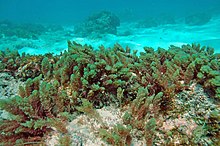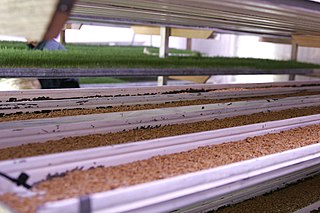
Fodder, also called provender, is any agricultural foodstuff used specifically to feed domesticated livestock, such as cattle, rabbits, sheep, horses, chickens and pigs. "Fodder" refers particularly to food given to the animals, rather than that which they forage for themselves. Fodder includes hay, straw, silage, compressed and pelleted feeds, oils and mixed rations, and sprouted grains and legumes. Most animal feed is from plants, but some manufacturers add ingredients to processed feeds that are of animal origin.
Burping is the release of gas from the upper digestive tract of animals through the mouth. It is usually audible.

Bromoform is an organic compound with the chemical formula CHBr3. It is a colorless liquid at room temperature, with a high refractive index and a very high density. Its sweet odor is similar to that of chloroform. It is one of the four haloforms, the others being fluoroform, chloroform, and iodoform. It is a brominated organic solvent. Currently its main use is as a laboratory reagent. It is very slightly soluble in water and is miscible with alcohol, benzene, chloroform, ether, petroleum ether, acetone and oils.
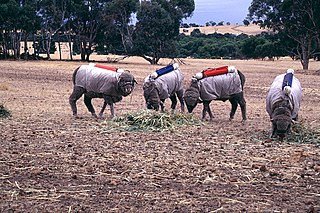
Enteric fermentation is a digestive process by which carbohydrates are broken down by microorganisms into simple molecules for absorption into the bloodstream of an animal. Because of human agricultural reliance in many parts of the world on animals which digest by enteric fermentation, it is the second largest anthropogenic factor for the increase in methane emissions directly after fossil fuel use.

Ceramium is a genus of Ceramium algae. It is a large genus with at least 15 species in the British Isles.
Schmitzia hiscockiana is a small, rare, red seaweed or marine alga of the phylum Rhodophyta or red algae. It was discovered and named in 1985.

Gastroclonium reflexum is a small red alga (Rhodophyta) reported from Ireland and Britain.
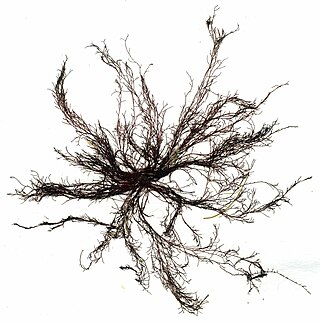
Polysiphonia is a genus of filamentous red algae with about 19 species on the coasts of the British Isles and about 200 species worldwide, including Crete in Greece, Antarctica and Greenland. Its members are known by a number of common names. It is in the order Ceramiales and family Rhodomelaceae.

Seaweed, or macroalgae, refers to thousands of species of macroscopic, multicellular, marine algae. The term includes some types of Rhodophyta (red), Phaeophyta (brown) and Chlorophyta (green) macroalgae. Seaweed species such as kelps provide essential nursery habitat for fisheries and other marine species and thus protect food sources; other species, such as planktonic algae, play a vital role in capturing carbon and producing at least 50% of Earth's oxygen.

Rhodochorton is a genus of filamentous red alga adapted to low light levels. It may form tufts or a thin purple "turf" up to 5 millimetres high. The filaments branch infrequently, usually at the tips.

Asparagopsis armata is a species of marine red algae, in the family Bonnemaisoniaceae. English name(s) include red harpoon weed. They are multicellular eukaryotic organisms. This species was first described in 1855 by Harvey, an Irish botanist who found the algae on the Western Australian coast. A. armata usually develops on infralittoral rocky bottoms around the seawater surface to around 40m of depth. Marine algae like A. armata are considered "autogenic ecosystem engineers" as they are at the very bottom of the food chain and control resource availability to other organisms in the ecosystem.

Red algae, or Rhodophyta, are one of the oldest groups of eukaryotic algae. The Rhodophyta comprises one of the largest phyla of algae, containing over 7,000 currently recognized species with taxonomic revisions ongoing. The majority of species (6,793) are found in the Florideophyceae (class), and mostly consist of multicellular, marine algae, including many notable seaweeds. Red algae are abundant in marine habitats but relatively rare in freshwaters. Approximately 5% of red algae species occur in freshwater environments, with greater concentrations found in warmer areas. Except for two coastal cave dwelling species in the asexual class Cyanidiophyceae, there are no terrestrial species, which may be due to an evolutionary bottleneck in which the last common ancestor lost about 25% of its core genes and much of its evolutionary plasticity.

Edible seaweed, or sea vegetables, are seaweeds that can be eaten and used for culinary purposes. They typically contain high amounts of fiber. They may belong to one of several groups of multicellular algae: the red algae, green algae, and brown algae. Seaweeds are also harvested or cultivated for the extraction of polysaccharides such as alginate, agar and carrageenan, gelatinous substances collectively known as hydrocolloids or phycocolloids. Hydrocolloids have attained commercial significance, especially in food production as food additives. The food industry exploits the gelling, water-retention, emulsifying and other physical properties of these hydrocolloids.

Asparagopsis taxiformis, formerly A. sanfordiana, is a species of red algae, with cosmopolitan distribution in tropical to warm temperate waters. Researchers have demonstrated that feeding ruminants a diet containing 0.2% A. taxiformis seaweed reduced their methane emissions by nearly 99 percent.
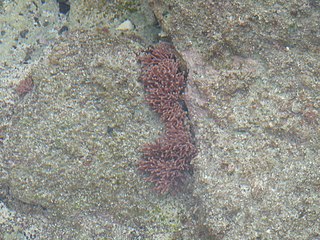
Amphiroa is a genus of thalloid red algae under the family Corallinaceae.

Jania is a genus of red macroalgae with hard, calcareous, branching skeletons in the family Corallinaceae.

Cordylecladia erecta is a species of red algae in the family Rhodymeniaceae. It is found in the north east Atlantic Ocean and the Mediterranean Sea and is the type species of the genus.
The production of cattle has a significant environmental impact, whether measured in terms of methane emissions, land use, consumption of water, discharge of pollutants, or eutrophication of waterways.
The taxon Ceramium siliquosum is a small marine alga. It belongs to the red algae genus Ceramium.

FutureFeed was established by Australia's Commonwealth Scientific and Industrial Research Organisation (CSIRO), FutureFeed holds the global intellectual property for the use of Asparagopsis seaweed as a ruminant livestock feed ingredient that can reduce methane emissions by 80% or more. This result can be achieved by the addition of a small amount of the seaweed into the daily diet of livestock. This discovery was made by a team of scientists from CSIRO and James Cook University (JCU), supported by Meat & Livestock Australia (MLA), who came together in 2013 to investigate the methane reduction potential of various native Australian seaweeds.
